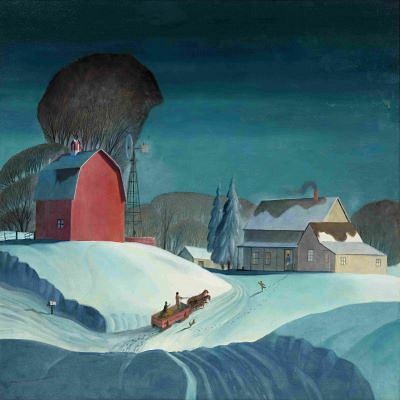Giovanni Battista Cimaroli (Italian, 1687-1771) Landscape along the Brenta with a stone bridge, shepherds and herds, early 1740s
Lot 113
About Seller
Hindman
1338 West Lake Street
Chicago, IL 60607
United States
Recognized as the Midwest's leading fine art auctioneers, Hindman Auctioneers has built a worldwide reputation based on a full service approach to the auction business tailored to meet the individual needs of our clients. Coming from a variety of educational backgrounds, specialists bring years of e...Read more
Estimate:
$10,000 - $20,000
Absentee vs Live bid
Two ways to bid:
- Leave a max absentee bid and the platform will bid on your behalf up to your maximum bid during the live auction.
- Bid live during the auction and your bids will be submitted real-time to the auctioneer.
Bid Increments
| Price | Bid Increment |
|---|---|
| $0 | $25 |
| $500 | $50 |
| $1,000 | $100 |
| $2,000 | $250 |
| $5,000 | $500 |
| $10,000 | $1,000 |
| $20,000 | $2,500 |
| $50,000 | $5,000 |
| $100,000 | $10,000 |
About Auction
By Hindman
Dec 10, 2020
Set Reminder
2020-12-10 11:00:00
2020-12-10 11:00:00
America/New_York
Bidsquare
Bidsquare : American and European Art
https://www.bidsquare.com/auctions/hindman-auctions/american-and-european-art-6049
Hindman Bidsquare@hindmanauctions.com
Hindman Bidsquare@hindmanauctions.com
- Lot Description
Giovanni Battista Cimaroli
(Italian, 1687-1771)
Landscape along the Brenta with a stone bridge, shepherds and herds, early 1740s
oil on canvas
22 ½ x 28 ½ inches.
We are grateful to Dott.ssa Federica Spadotto for endorsing the attribution to Cimaroli on the basis of photographs, and proposing a date of execution in the early 1740s.
Provenance:James Kinnaird, EsquireHenry Graves, LondonThe Honorable G.F. Wynn, purchased from the estate sale of the above, 1893Lieutenant Honorable Lord Newborough, Glynllifon, Wales, EnglandM. Knoedler & Co., New York, by 1940 Exhibited:Great Chitral Fair (no date), no. 805New Haven, Connecticut, Yale University, Gallery of Fine Arts, Eighteenth Century Italian Landscape Painting and its Influence in England, January 18 - February 25, 1940, no. 33, illus. (as River Scene and attributed to Francesco Zuccarelli (Italian, 1702-1788))Houston, Texas, Museum of Fine Arts, Houston, Historic and Modern Examples of "Cattle in Art," February 2 - 16, 1941 (as View on the Piave; River Scene and Cattle and attributed to Francesco Zuccarelli (Italian, 1702-1788))San Francisco, California, California Palace of the Legion of Honor, Exhibition of Italian Baroque Painting, 17th and 18th Centuries, May 16 - June 15, 1941, no. 115 (as attributed to Francesco Zuccarelli (Italian, 1702-1788))
This evocative landscape was executed at the height of Giovanni Battista Cimaroli's career, when the Lombard master, known for his views closely related to those of Canaletto (Italian, 1697-1768) found his locus between the banks of the Brenta river. The muted palette, along with the precise pictorial handwriting, is evidence that the artwork was painted in the early 1740s and is of a purely Lombard brand. During the early 18th century, Grand Tour travelers, privileged patrons of the Italian landscape, turned their attention to the riviera that connects Venice and Padua. This idyllic Eden was celebrated in a volume of engravings by Gian Francesco Costa with the suggestive title "Of the delicacies of the Brenta river" (1750) and was enjoyed by Venetian nobles and foreign gentlemen alike. Occasionally, these grandees allowed themselves to be immortalized among the villages and villains. Cimaroli even painted himself as a knight in the foreground of one painting. (F. Spadotto, Giovan Battista Cimaroli, catalogo ragionato dei dipinti, Minelliana, Rovigo, 2011, no.101). In this painting, behind Cimaroli unravels the town of Dolo, faithfully following a perspective technique begun by Canaletto. (W.G. Constable, Canaletto. Giovanni Antonio Canal 1697-1768, Oxford, 1962, 2 vol.). Several times Canaletto himself attempted to transpose the rural villages onto canvas, and he devoted some important engravings to these views, which are included in "Vedute prese dai luoghi ed altre ideate..." (1744 - c. 1752). All this testifies to the multiple appealing elements enjoyed by the riveria, ranging from the villas that dotted it to the picturesque rustic buildings populated by communities of simple and happy people. Life seemed to flow as in the verses of the Virgilian Bucolics, in which the hard life of the fields was ignored in favor of a nature ready to bestow the dolorous warmth of the midday sun that caresses luxuriant plants and placid streams in an eternal spring.
The present canvas falls within this idyllic landscape genre, depicting in the foreground a stone bridge crossed by grazing cows, sheep, and goats. Cimaroli masterfully transfers the smallest details of the composition with extreme verisimilitude. His hand is communicated in the leaves of the unmistakable, large tree that dominates the composition and in the animals in the foreground, which recur in numerous works by the artist. The fading horizon, which the gaze reaches after resting on the stone arch and on the rustic buildings scattered about the pleasant countryside, carries the painting from tale to idyll; from the recording of the visual data to the sweet memory, where reality takes on the characteristics of a dream. The adopted Venetian artist managed, perhaps better than any other master in the Lagoon, to recreate a piece of the countryside through the vibrations of the soul, with the discreet elegance of a craftsman who becomes a poet. The branches of the large tree bear witness to this, reproduced in every detail, as well as the precision with which the artist transfers buildings to the canvas. However, any glimpse of a landscape that resembles the true Venetian countryside is purely accidental. In fact, in no corner of the Venetian hinterland will be found the same trees, or the course of the river in that shape; and it will not be because of the passage of time.
For Cimaroli's clients, objectivity represented a completely unknown concept. The artist was not asked to fix the image of a place, but to evoke its atmosphere, to remember as it is on the canvas, and to be relived on cold winter days, in distant homes, often immersed in the mist of the Channel. Although typical of the inventio genre, the extraordinary expressive quality of this composition makes it a fundamental addition to the corpus of the Lombard master in his best creative period. Federica Spadotto, Padua, September 8, 2020
Condition
For condition inquiries please contact Mary Grace Bilby at marygracebilby@hindmanauctions.com - Shipping Info
-
Please refer to https://hindmanauctions.com/shipping-packing
-
- Buyer's Premium



 EUR
EUR CAD
CAD AUD
AUD GBP
GBP MXN
MXN HKD
HKD CNY
CNY MYR
MYR SEK
SEK SGD
SGD CHF
CHF THB
THB














